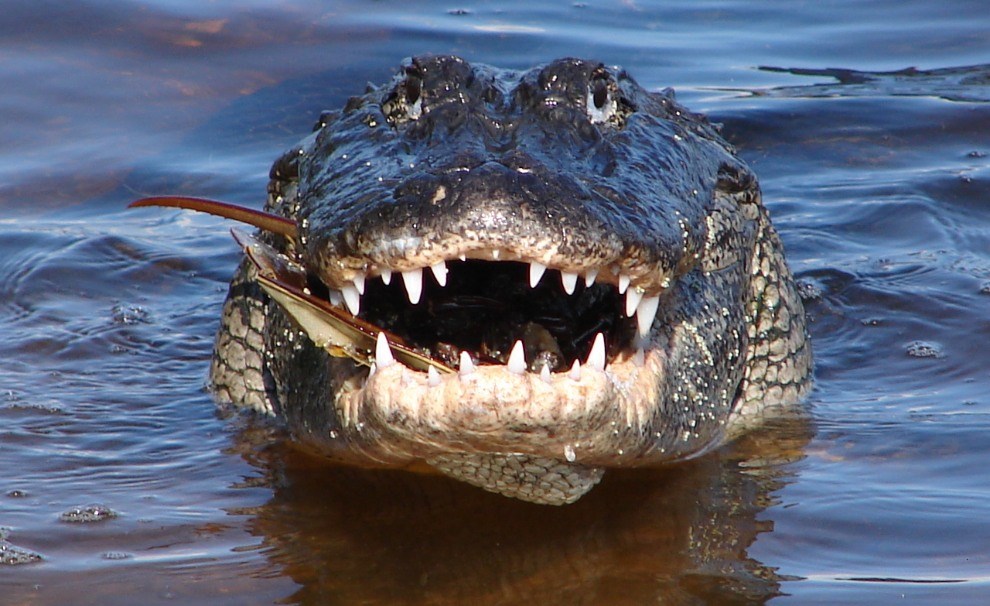Last updated: July 16, 2019
Article
Animal Populations

USFWS photo.
Hurricanes can cause widespread ecological disturbance but affect resident organisms differently. Many invertebrate and vertebrate populations are minimally affected by tropical storms or are highly resilient to such disturbances (Michener et al. 1997). Affected populations will likely recover more rapidly if they are adjacent to unaffected areas with high populations or if an individual species has relatively high mobility. There are exceptions, however, in particular species that already have declining populations or are severely restricted in habitat such as gopher tortoise (Gopherus polyphemus) (Kushlan and Mazzotti 1984) and American crocodile (Crocodylus acutus) (Ogden 1978). Moreover, storm-related flooding can drown terrestrial vertebrates, including mammals, especially when they are raising young.
Here are some examples of how storms affect various species:
- Storm-surge inundation of coastal wetlands during Hurricane Andrew (1992) caused muskrat (Ondatra zibethicus) mortality. This type of flooding can be especially devastating for juveniles in lodges (Kinler et al. 1990).
- Alligators (Alligator mississippiensis) were displaced, but not killed, in coastal Louisiana following Hurricane Audrey (1957) (Ensminger and Nichols 1958).
- Hurricane Hugo (1989) did not affect adult populations of the most common leptodactylid frog (Eleutherodactylus coqui) in Puerto Rico, which increased after the storm, but juveniles suffered high mortality as a result of the storm, possibly because of desiccation (Woodbright 1991).
- Insects may survive storms relatively well because of the persistence of their larvae and pupae; however, walking stick (Lamponius portoricensis and Agamemnon iphimedeia) were drastically reduced after Hurricane Hugo (1989) because of flooding during the storm (Willig and Camilo 1991; Waide 1991).
- Hurricane Hugo’s (1989) storm surge significantly reduced whitetail deer (Odocoileus virginianus) and squirrel (Sciurus spp.) populations in selected areas (Cely 1991).
- Nutria (Myocastor coypus), muskrat, raccoon (Procyon lotor), rabbit (Sylvilagus spp.), and deer populations were significantly reduced in coastal Louisiana following Hurricane Audrey (1957) (Ensminger and Nichols 1958).
- Gunter and Eleuterius (1971) reported widespread mortality among harvest mice (Reithrodontomys humulis) and raccoons in the wake of Hurricane Betty (1972) in Mississippi.
- Investigators tracked a group of manatees (Trichechus manatus latirostris) in southwest Florida with satellite transmitters during Hurricanes Charley (2004), Katrina (2005), and Wilma (2005); data showed that these animals made no significant movement before and during storm passage (Langtimm et al. 2006).
- Hurricane Andrew (1992) scoured the tops of massive Acropora brain coral on some reefs, washing away boulders of 200-year-old coral communities and breaking off other branching varieties (Magorien 2004).
- The juvenile spiny lobster (Panulirus argus), which is normally found under sponges and corals in Biscayne Bay, disappeared after Hurricane Andrew (1992) (Magorien 2004).
- Surveys after the 2004 hurricane season in Florida showed that although these storms had immediate effects on some fish assemblages (e.g., in Tampa Bay and Charlotte Harbor), these assemblages generally appeared quite resilient to natural environmental perturbations from a decadal perspective (Greenwood et al. 2006).
- In the Tijuana Estuary in San Diego, California, the Great Storm of ’88 displaced all invertebrates and fishes as a sand plume flowed over the site. Sedimentation of one of the estuary’s main channels caused this local extinction (Fink 1989).
